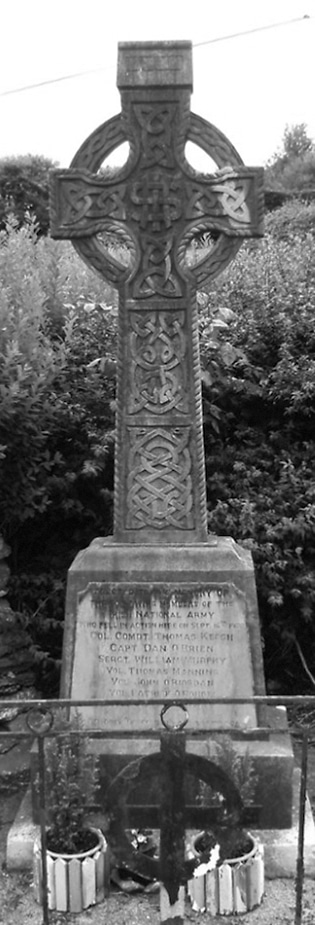There are many monuments commemorating events from the 1919-1923 period dotted along the N22. Midway between Macroom and Ballyvourney you will find two memorials at Carrigaphooca; a Celtic cross commemorating seven Free State soldiers who died in a mine explosion on September 15,1922 stands just feet away from a plaque commemorating an IRA Volunteer killed as a reprisal. Pauline Murphy shares the history behind these memorials.

The most high profile casualty at Carrigaphooca was Commandant Tom Keogh. Whilst travelling in a military lorry from Macroom to Kerry, Keogh and his men came upon an obstruction on the road at Carrigaphooca and discovered a mine hidden underneath. As the leads connecting the mine to the detonator had been cut, the soldiers mistakenly thought it was safe to remove; they had failed to notice it had been rigged to a hand grenade hidden beneath, that exploded when the mine was lifted.
The explosion resulted in the instant deaths of Captain Daniel O’Brien of Macroom; Sergeant William Murphy from Longford; Privates Thomas Manning and John O’Riordan from Macroom; Patrick O’Rourke, a WWI veteran, and Ralph Conway of Athlone. Grisly local lore tells how people in the area were still finding body parts in fields and ditches many weeks after the incident.
Commandant Keogh was the only survivor found at the scene. His legs had been blown off and he had injuries to his abdomen. He was taken by ambulance to the Mercy Hospital in Cork City but, so severe were his injuries, he died later that night.
Keogh was a 23-year-old Carlow native who had fought in the 1916 Easter Rising and was a leading member in Michael Collins’ famous ’12 Apostles’, also known as ‘The Squad’, during the War of Independence. Keogh carried out assassinations of Dublin Castle detectives during Bloody Sunday 1920 and was arrested following the Customs House fire in 1921. Released after the truce, Keogh remained loyal to Collins and became a Commandant in the newly formed Free State army.
Michael Collins’ sister Mary, who resided near the Mercy Hospital, went to see Keogh and was present when he died. She wrote a letter to Keogh’s mother and attached a lock of his hair: “I was present when Tom died, he died like a tired child going to sleep, he just closed his eyes and his mouth, and all was over. The nuns and a few of his comrades had the privilege of saying a few prayers for his gallant soul. I remained while they washed him, his lovely white young body so broken and battered. God love him. I’am sure, that after all his brave fights, god took him to join the Big Fellow.”
The Carrigaphooca explosion enraged the Free State troops based in Macroom Castle and some set out for revenge. The following day, September 16, 1922, members of the Dublin Guard, who were based in Macroom, including Collins Squad members James Conroy and James Slattery, brought IRA prisoner James Buckley from custody to the scene of the explosion, where they beat him before shooting him dead.
Anti-Treaty IRA Volunteer James Buckley was a 46-year-old labourer from Clounfada, Macroom. He was a member of the 7th Battalion Cork IRA No.1 Brigade and had taken part in many actions across West Cork throughout the War of Independence.
Buckley had been captured the day before the Carrigaphooca explosion, during a skirmish at Gortnalika and had nothing to do with the mine at Carrigaphooca yet his bullet-riddled body was found in the crater where the mine had exploded.
This revenge killing disgusted many Free State soldiers, especially soldiers from the locality, who downed arms in protest, causing Free State General Tom Ennis to leave his post in Cork City and go to Macroom to calm the situation.
Local Free State Commandant Peadar O’Conlon wrote to Major General Emmet Dalton: “The shooting of this prisoner has caused considerable contempt amongst the garrison here. They have paraded before me and have given me to understand that they will not go out on to the hills anymore. Therefore you will want to tell these officers from Dublin that they will want to stop that kind of work or they will corrupt the Army…If I was taken prisoner, I would want to be treated as one. Therefore we must do the same. I oppose Dublin Guard policy in the strongest way i.e, any revenge killing like that of James Buckley.”
Dalton in turn wrote to Minister for Defence and Army Commander in Chief Richard Mulcahy that he “personally approved of Dublin Guard action” but lamented that most of the men in his command did not. Dalton suggested to Mulcahy “It would be better if you kept the squad out of my area.”
Some squad members from The Dublin Guard were sent back to Dublin while others went westwards, across the county bounds. With their distinct dark green uniform they stood out from the lighter Free State attire and many people in West Cork and Kerry tagged them as ‘the green and tans’.
James Buckley is buried in Clondrohid and is commemorated on the IRA memorial in Macroom town square. His death was not the first nor would it be the last time an IRA prisoner in custody died in violent fashion.
Just a week before the Carrigaphooca explosion and revenge murder of Buckley, the mutilated body of IRA Captain Tadgh Kennefick was discovered in Coachford. He had been arrested by Free State troops under the command of General Dalton and tied to the back of a military lorry. Kennefick was dragged to a spot near Rooves Bridge where he was beaten shot before his body was dumped in a field nearby.
This bloody and brutal episode in the Irish Civil War was just the beginning of a series of terrible acts carried out on former comrades. The actions of the Dublin Guard in the South West was raised in the Dáil by Labour TD Tomas de Nogla. Even the crown authorities were taking note of the dire situation. A British Military intelligence report from the Autumn of 1922 noted “several republicans have been murdered under extremely revolting circumstances.”
1923 was no better. The Dublin Guard had turned their attention to Kerry where over 40 IRA prisoners in their custody were murdered.
One hundred years later, on the busy N22, many motorists whizz past Carrigaphooca, oblivious of this spot where blood was shed in a brutal and bitter conflict that scarred Ireland for many generations.




